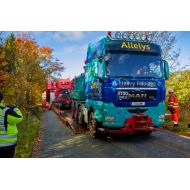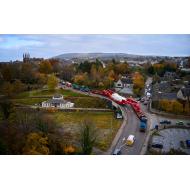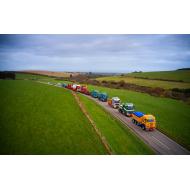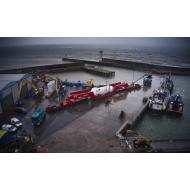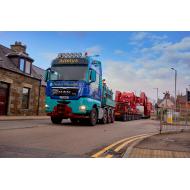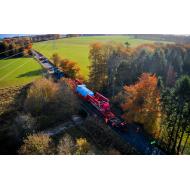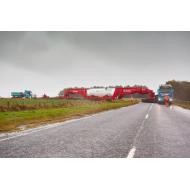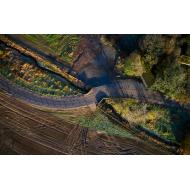1. Project Overview
THLG members, Allelys for the UK and Rofl Riedl for Germany, have collaborated and executed the delivery of a 158te transformer, a 352te generator and 91 general cargo (GC) components from across Europe to Rothienorman Substation in Scotland. Rofl Riedl were awarded the overseas and overland transportation and logistics packages for both the general cargo and over dimensional cargo (ODC). The ODC overland transportation from Buckie Harbour to Rothienorman Substation and onsite installation was then subcontracted to Allelys.
This project has been entered for the job of the year due to the wide-ranging challenges and complexities that were overcome to enable this project to be delivered successfully. These included:
- Feasibility studies such as route surveys, swept path analysis and topographical surveys.
- Utilising a range of specialist trailers to complete different sections of the route.
- Multi modal transportation.
- Removal of vegetation, street furniture and fencing.
- An extension to the width of one of the roads to accommodate the cargo dimensions.
- An overbridging operation to support the heavy cargo weight.
- Restricted space.
- Steep inclines.
- Severe weather conditions during execution.
Project Details:
| Start date | February 2022 |
| End date | November 2023 |
| Transported from |
|
| Transported to | Rothienorman Substation |
| Load weight |
|
| Services Provided | Equipment Used |
| Transportation | 12 axle SPMT |
| Swept path analysis | 14 axle SPMT |
| Route surveys | 16 axle girder frame |
| Structure analysis | 28 axle girder frame |
| Bridge analysis | 6 ballast tractor units |
| Consultation | Mobile crane |
| Fabrication | Franne crane |
| Load spreading | Lifting gantry |
| Overbridging | Climbing jacks |
| Project management | Mats and stools |
| Engineering | Standard flat trailers |
| Installation | General tractor units |
| Lift plan & management | Gearless vessel |
| Lifting | Barge |
| Skidding | |
| Jacking | |
| Shipping |
2. Project Preparation and Complexity
The safe and timely delivery of this project was paramount, therefore a significant planning phase was established, beginning in February 2022. A project team across both businesses comprising of Commercial Managers, engineers, HSEQ, logistics and operations was set up and led by the designated Project Manager alongside a project file being initiated, so that all stakeholders could access relevant information. Regular meetings were held both internally and with the customer, multiple site visits were completed, as well as regular calls with Transport Scotland, Scotland Police, Amey and Aberdeenshire Council to ensure the early buy-in from each company and the best possible working relationship.
The most significant challenge for the project was the route. Although abnormal loads had been transported previously to a neighbouring site, the components within this project were significantly bigger than anything that had been transported along this route before. The team faced the challenge of engineering a safe and viable route to transport these components and break the existing record for the heaviest cargo transported.
The combined team dedicated over 400 hours to the FEED stage of this project, completing the initial survey, then a land-based survey, analysing the results and completing calculations on every pinch point of the route. Swept path analysis and topographical surveys were also conducted to determine route feasibility. With a route engineered and proposed, each structure along the route needed to be checked and cleared, with an individual solution designed for every section of the route, incorporating specific enabling works, wherever they were required.
3. Solution
The team worked together to identify a solution to each and every challenge faced within the planning stage. Without this tailored multi modal solution the client would have no alternative but to dismantle the cargo and ship them the site as individual components, creating extensive delays and huge costs to the project.
Shipping and port options
In the early stages of the project Rolf Riedl had been working to identify the appropriate port and shipping options for the ODC cargo. This would be largely based on route assessments and structural analysis from the combined team. Based on the RFQ it was agreed to take receipt of the Transformer at Rijeka port in Croatia and the generator from FOB at the factory in Mülheim, Germany.
Different transport and shipping concepts were investigated and evaluated in accordance with the various project scenarios. These included possible ports for shipping of the generator across Europe including Rotterdam, Antwerp and Hamburg, ports of entry into Scotland and the overall technical feasibility of the transport solution itself. This was in addition to the economic impact of the different transport concept costs, as well as the collection and timing options.
Based on the extensive route survey, bridge assessments and discussions with the authorities considered Hamburg was agreed as the most practical port to ship the generator from and Buckie Harbour was identified as the designated port of entry.
The overall concept for the general cargo was to achieve eco-friendly, economic and safe transportation of all materials identified within the scope of work. In order to achieve these goals, Rolf Riedl arranged maximum possible consolidations from across Europe.
Limited space at the port
The cargo was scheduled to arrive into Buckie Harbour and Allelys were required to lift the units directly from the vessel onto the designated transport arrangement – a girder frame trailer. However, the limited space at the port meant that there wasn’t the necessary area available to position the crane and the girder frame at the same time.
A solution was designed to mobilise half of the girder frame and push the trailer to the end of the pier. The LG1550 crane was then rigged in front of the trailer to lift the 352te generator and position it onto bog mats, also in front of the trailer. The 158te transformer was then lifted and received onto 12 axle lines of SPMT and transported to temporary storage. The LG1550 was then derigged to allow space for the second half of the girder frame to be moved into position.
Culvert on route
Along the route was a culvert that was privately owned. With the owners concerned of the potential damage the two abnormal loads could cause, Allelys devised a solution to satisfy the owners, enable a safe transport system and protect the culvert from damage. The solution required the use of steel plates that were positioned across the culvert. This enabled the load to be spread as much as possible and allowed the transport configuration to travel across without any damage to existing infrastructure.
During the FEED stage, all of the structures along the route had been cleared and therefore the special-order permit was applied for. However, 6 weeks before the transport date Allelys were contacted by the local council and informed that one of the bridges, Gardensmill Bridge, had undergone a recent condition survey and the findings resulted in the structure being downgraded – therefore it was not possible to travel across the structure.
The engineering team worked quickly and diligently to design a solution that meant that the transport still went ahead on schedule. A 17.5m overbridging operation was engineered to enable the girder frame to traverse over the entire bridge structure, rather than exerting load into the structure itself. A solution that meant the project could go ahead as planned, whilst protecting the downgraded structure.
Record breaking loads
The size of these units were bigger than any that had ever travelled this route previously and there was one particular section of the route that proved the most challenging. Only 500m before the site entrance was a sharp left-hand turn, followed by a right-hand turn. As well as a small stone arch bridge with high parapets and some trees on the offside. The engineering studies showed that the transport arrangement was just too large to travel through this section.
Whilst other companies would then deem this route as impossible, Allelys used their extensive knowledge and experience to devise a new solution. The engineering team designed a new road layout that would allow the cargo to safely travel around each bend and over the bridge. This new layout required significant alterations to widen the road considerably. These road widening exercises enabled the transport to travel as straight as possible to then continue the journey to site. Foliage was also removed to allow safe passage once across the bridge.
Severe weather conditions
In the days leading up to the transport, severe weather hit the UK. This weather front was classified as Storm Babet and with the area becoming flooded, safety considerations were paramount. The Allelys team worked diligently to analyse any potential further challenges arising from the weather. On the steepest section of the route, the engineering team had designed a solution using 4 tractor units to provide 83.2te of tractive effort. With the cargo requiring 67.6te, this solution provided an additional 15.6te of contingent tractive effort.
Due to the weather conditions, the team recalculated to ensure that all possible risks were mitigated. Considering the steep incline of the road and with flooding and drains blocked in the area, a new solution was proposed to use an additional 2 tractor units to provide a total of 124.8te of tractive effort, nearly double the requirement.
All of these individual solutions combined to plan and prepare for a record-breaking move. The whole team worked closely to ensure that everything met all of the safety accreditations that Allelys work to including ISO 9001, 14001 and 45001 as well as FORS and Safe Contractor. The dedicated HSEQ team assisted, reviewed and assessed each stage for compliance and ensured that all risks were mitigated where possible.
4. Execution
Once the execution phase began, Allelys’ expert operational team were fully briefed and provided with detailed risk assessments and method statements for all stages of the operation. This knowledge was evident during the complicated offloading procedure that was completed to absolute precision.
With the transformer in temporary storage, the generator, which weighed 352te and measured 13m (l) x 4.1m (w) x 4.3m (h), was received by Allelys’ 28 axle girder frame trailer. The girder frame trailer navigated each stage of the engineered route safely and in a controlled manner. Travelling over the culvert, traversing across the downgraded bridge structure and manoeuvring through the widened road section. The meticulous planning was evident throughout, but especially with the over sail of the bridge parapets being as little as 10mm.
When approaching the steep incline, the decision was made to move to the contingency plan of stopping within the road closure and mobilising two extra trucks to provide the necessary traction. The correct decision with the road holding too much water and impacting on the traction of the equipment.
Once at site, the generator was transhipped onto a 14 axle SPMT due to the limited space available on site and to reduce the ground loadings before entry to the turbine hall. Allelys hydraulic gantry system was utilised to install the generator to its foundation.
The route was then repeated with the transformer, which weighed 158te and measured 8.5m (l) x 3.4m (w) x 4.5m (h). Transported on a smaller 16 axle girder frame, but approaching each pinch point of the route with the same precision as the first transport to complete a successful execution.
5. Conclusion
This project not only demonstrated the knowledge and experience within the combined businesses, but also the ability to adapt to a range of challenges to ensure a successful delivery for our client. As a combined team effort all heavy lift and specialist transport aspects of the project were managed and engineered in-house, helping showcase the capabilities of THLG members.
Across the whole scope of work, this project saw a variety of transportation techniques combined to safely deliver the cargo to site. With gearless vessels, standard flat trailers, 12 axle SPMTs used in the port, 16 and 28 axle girder frame trailers used along the route and 14 axle SPMTs used on site. These abnormal loads, bigger than any previous cargo, navigated the engineered route with precision, following meticulous planning and to the highest HSEQ standards.
Full project video can be viewed at https://www.youtube.com/watch?v=uAWk5G77mwk

